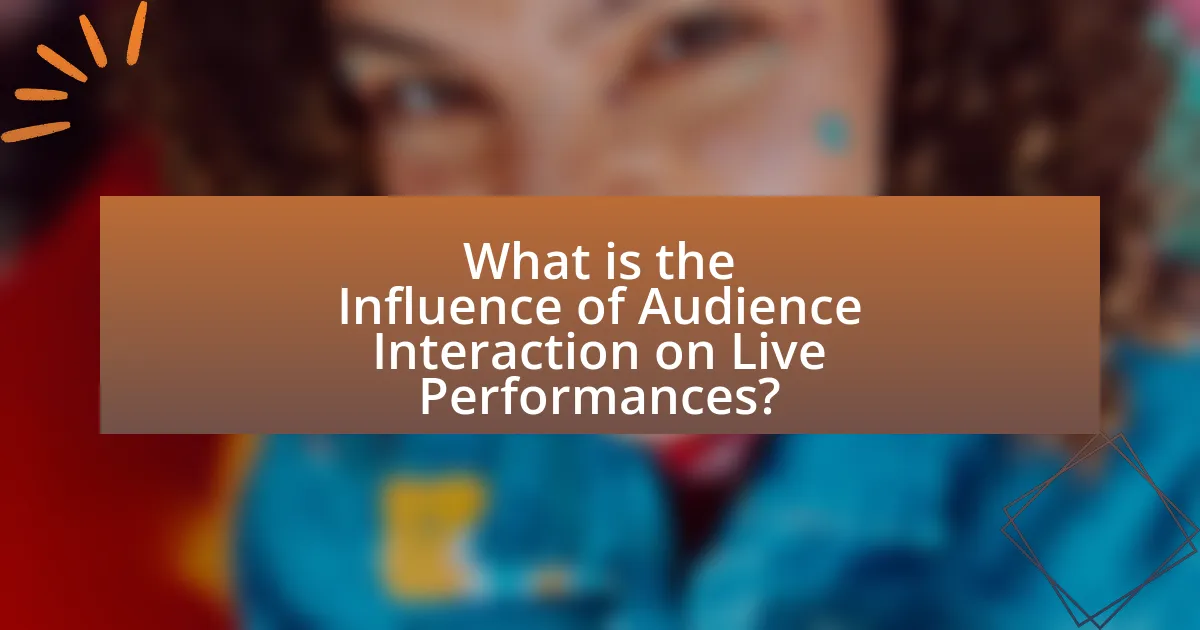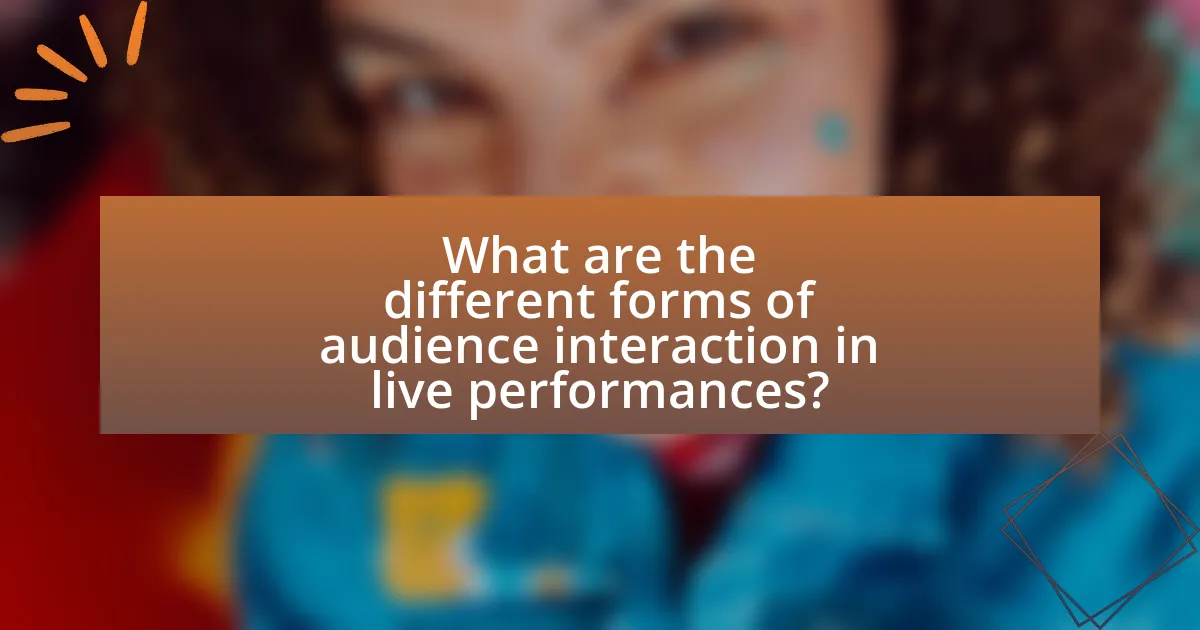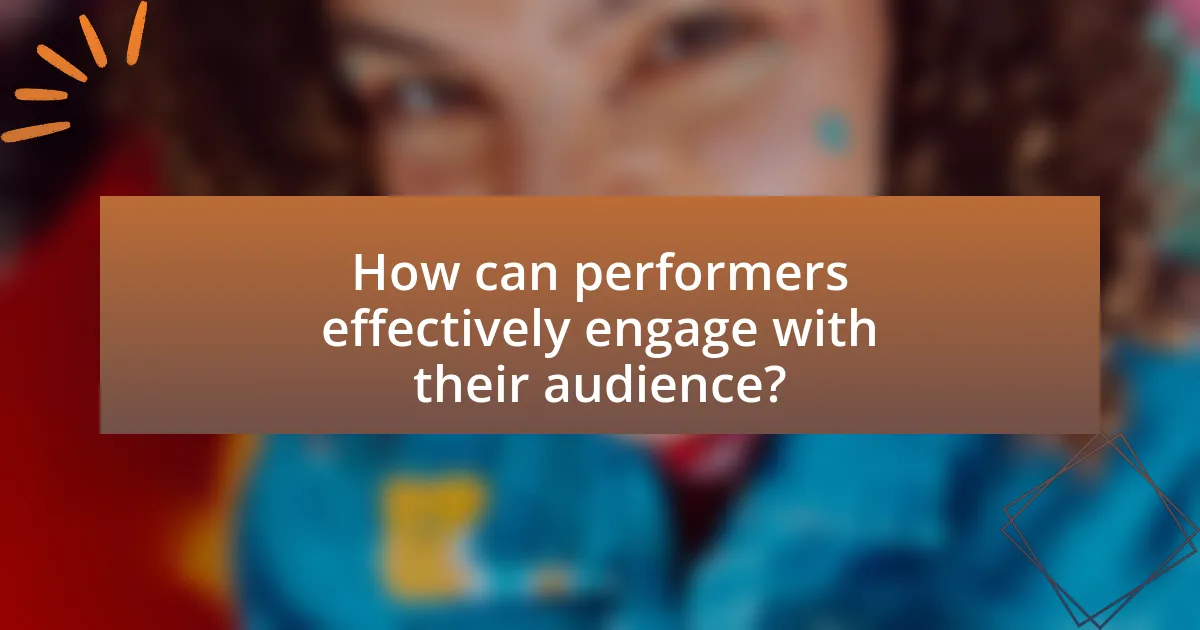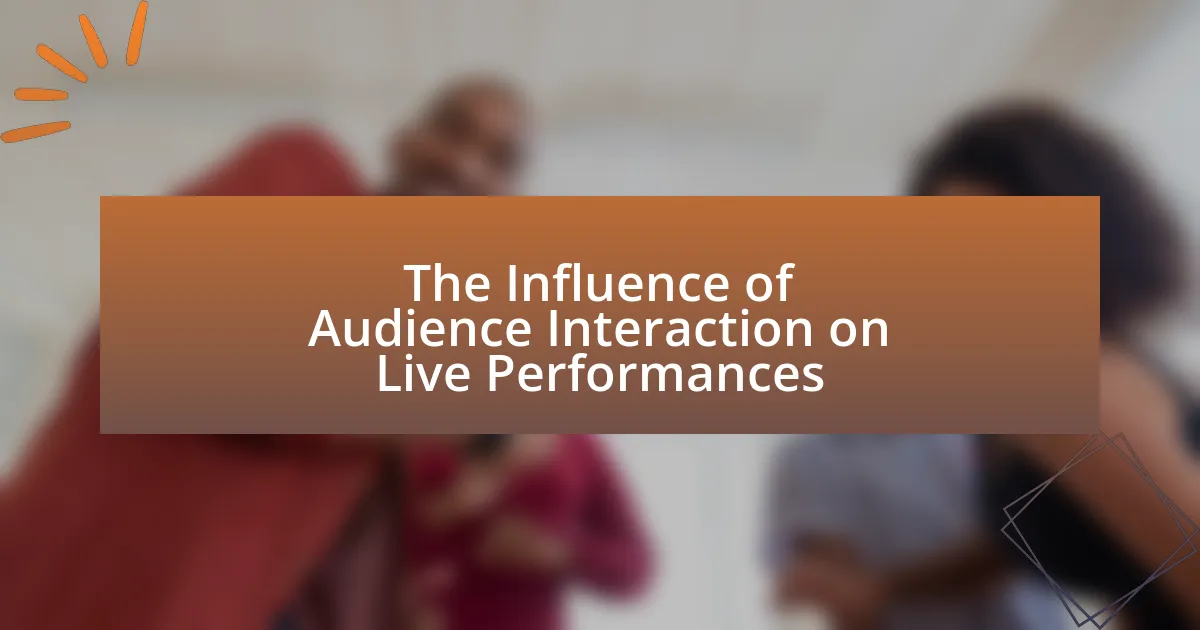The article examines the influence of audience interaction on live performances, highlighting how such engagement enhances the connection between performers and spectators. It discusses various forms of audience interaction, including applause, vocal responses, and physical engagement, and their impact on performance quality and performer psychology. The article also explores the role of technology in facilitating interaction, cultural differences in engagement styles, and strategies for performers to manage audience behavior effectively. Key findings indicate that active audience participation leads to increased enjoyment, emotional resonance, and overall satisfaction during live events.

What is the Influence of Audience Interaction on Live Performances?
Audience interaction significantly enhances live performances by fostering a dynamic connection between performers and their audience. This interaction can lead to increased engagement, emotional resonance, and a more memorable experience for attendees. Research indicates that when audiences actively participate, such as through clapping, singing along, or responding to prompts, performers often adjust their delivery and energy levels, creating a feedback loop that elevates the overall performance quality. For instance, a study published in the Journal of Applied Psychology found that audience engagement can boost performers’ confidence and creativity, resulting in more spontaneous and authentic expressions during the show.
How does audience interaction shape the experience of live performances?
Audience interaction significantly shapes the experience of live performances by enhancing engagement and emotional connection between performers and spectators. When audiences actively participate, such as through clapping, singing along, or responding to cues, it creates a dynamic atmosphere that energizes both the performers and the audience. Research indicates that this interaction can lead to increased enjoyment and satisfaction, as evidenced by a study published in the Journal of Applied Psychology, which found that audiences who engaged with performers reported higher levels of emotional arousal and overall experience quality. This reciprocal relationship fosters a sense of community and shared experience, making live performances more memorable and impactful.
What types of audience interactions are most common during live performances?
The most common types of audience interactions during live performances include applause, vocal responses, and physical engagement such as dancing or clapping. Applause serves as a primary feedback mechanism, indicating appreciation and encouraging performers. Vocal responses, such as cheering or singing along, enhance the communal experience and foster a connection between the audience and the performers. Physical engagement, like dancing or clapping, not only reflects enjoyment but also contributes to the overall atmosphere of the event, creating a dynamic interaction that can energize both the audience and the performers. These interactions are essential for creating an immersive and engaging live performance experience.
How do performers respond to audience feedback in real-time?
Performers respond to audience feedback in real-time by adjusting their performance based on the audience’s reactions, such as laughter, applause, or silence. This immediate feedback influences their energy levels, pacing, and even content delivery. For instance, a comedian may alter their jokes or timing if they sense the audience is not engaged, while a musician might extend a song or change the setlist based on crowd enthusiasm. Research indicates that performers often rely on non-verbal cues, such as body language and facial expressions, to gauge audience engagement, allowing them to make on-the-spot adjustments that enhance the overall experience.
Why is audience interaction important for live performances?
Audience interaction is important for live performances because it enhances the overall experience for both performers and attendees. Engaging with the audience fosters a sense of connection and community, which can lead to increased emotional investment in the performance. Research indicates that performances with high levels of audience participation often receive more positive feedback and higher satisfaction ratings. For instance, a study published in the Journal of Applied Psychology found that audience engagement can significantly boost performers’ energy levels and creativity, resulting in a more dynamic and memorable show.
What psychological effects does audience interaction have on performers?
Audience interaction significantly enhances performers’ psychological well-being by boosting their confidence and reducing anxiety. Engaging with an audience creates a feedback loop where positive reactions, such as applause or laughter, reinforce the performer’s self-efficacy and motivation. Research indicates that performers who experience active audience participation report higher levels of enjoyment and satisfaction, which can lead to improved performance quality. For instance, a study published in the Journal of Applied Psychology found that performers who received immediate audience feedback experienced lower stress levels and increased feelings of connection, ultimately enhancing their overall performance experience.
How does audience engagement enhance the overall performance quality?
Audience engagement significantly enhances overall performance quality by fostering a dynamic interaction between performers and spectators. This interaction creates an atmosphere of energy and enthusiasm, which can elevate the performers’ delivery and emotional expression. Research indicates that when audiences are actively engaged, such as through applause or participation, performers often respond with increased motivation and creativity, leading to a more compelling and memorable experience. For instance, a study published in the Journal of Applied Psychology found that performers who perceived higher audience engagement reported greater satisfaction and improved performance outcomes. This correlation underscores the importance of audience involvement in shaping the quality of live performances.

What are the different forms of audience interaction in live performances?
Different forms of audience interaction in live performances include verbal engagement, non-verbal cues, participation in activities, and feedback mechanisms. Verbal engagement occurs when audience members respond to performers through cheers, clapping, or vocal comments, enhancing the energy of the performance. Non-verbal cues, such as body language and facial expressions, allow performers to gauge audience reactions and adjust their delivery accordingly. Participation in activities, like sing-alongs or call-and-response segments, fosters a sense of community and involvement. Feedback mechanisms, such as post-performance discussions or social media interactions, provide performers with insights into audience perceptions and preferences, influencing future performances. These forms of interaction are essential as they create a dynamic atmosphere that can significantly enhance the overall experience for both the audience and the performers.
How do different genres of performances encourage audience interaction?
Different genres of performances encourage audience interaction through varying methods tailored to their unique characteristics. For instance, theater often involves direct engagement, such as breaking the fourth wall, where actors speak directly to the audience, fostering a sense of involvement. In contrast, concerts typically encourage interaction through call-and-response techniques, where performers invite the audience to sing along or respond to prompts, enhancing the communal experience. Additionally, improvisational comedy relies heavily on audience suggestions to shape the performance, creating a dynamic and participatory atmosphere. Research indicates that these interactive elements can significantly enhance audience enjoyment and emotional connection, as seen in studies highlighting increased audience satisfaction in participatory events compared to passive viewing experiences.
What role does technology play in facilitating audience interaction?
Technology plays a crucial role in facilitating audience interaction by providing platforms and tools that enhance communication and engagement during live performances. For instance, social media applications allow audiences to share their experiences in real-time, fostering a sense of community and participation. Additionally, interactive technologies such as mobile apps enable audience members to vote on aspects of the performance or submit questions, creating a two-way dialogue between performers and viewers. Research indicates that events utilizing audience response systems see a 30% increase in engagement levels, demonstrating the effectiveness of technology in enhancing interaction.
How do cultural differences influence audience interaction styles?
Cultural differences significantly influence audience interaction styles by shaping expectations, communication norms, and engagement levels during live performances. For instance, in collectivist cultures, audiences may prioritize group harmony and exhibit more subdued reactions, while in individualistic cultures, audiences often express enthusiasm and personal opinions more openly. Research by Hofstede (1980) highlights these cultural dimensions, indicating that high-context cultures tend to rely on non-verbal cues and implicit communication, affecting how audiences respond to performers. Conversely, low-context cultures favor explicit communication, leading to more direct and vocal audience interactions. This cultural framework illustrates how varying cultural backgrounds can dictate the dynamics of audience engagement, ultimately impacting the overall experience of live performances.
What are the potential challenges of audience interaction during live performances?
Potential challenges of audience interaction during live performances include disruptions to the performance flow, miscommunication, and varying audience engagement levels. Disruptions can occur when audience members shout or respond unexpectedly, which may divert the performer’s focus and alter the intended pacing. Miscommunication arises when performers and audience members interpret cues differently, leading to confusion and potential disengagement. Additionally, varying levels of audience engagement can create an imbalance, where some audience members are highly interactive while others remain passive, affecting the overall atmosphere and energy of the performance. These challenges can hinder the effectiveness of the interaction and impact the overall experience for both performers and attendees.
How can negative audience interactions impact a performance?
Negative audience interactions can significantly detract from a performance by disrupting the flow and focus of the performers. When audience members engage in disruptive behaviors, such as heckling or talking loudly, it can lead to a loss of concentration for the performers, which may result in a diminished quality of the performance. Research indicates that performers often report increased anxiety and stress levels when faced with negative audience interactions, which can further impair their ability to deliver a compelling show. For instance, a study published in the Journal of Applied Psychology found that performers who experienced negative feedback from the audience were more likely to exhibit decreased performance quality and increased emotional distress. This evidence underscores the critical impact that audience behavior has on live performances.
What strategies can performers use to manage disruptive audience behavior?
Performers can manage disruptive audience behavior by employing strategies such as setting clear expectations, maintaining engagement, and utilizing non-verbal cues. Setting clear expectations involves communicating behavior guidelines at the beginning of a performance, which can reduce disruptions by informing the audience of acceptable conduct. Maintaining engagement through interactive elements, such as asking questions or involving the audience in the performance, can keep attention focused and minimize distractions. Additionally, performers can use non-verbal cues, such as eye contact or gestures, to address disruptive behavior subtly without interrupting the flow of the performance. These strategies are supported by research indicating that proactive audience management can enhance overall performance quality and audience experience.

How can performers effectively engage with their audience?
Performers can effectively engage with their audience by utilizing interactive techniques such as direct communication, audience participation, and emotional connection. Direct communication involves addressing the audience, asking questions, and responding to their reactions, which fosters a sense of inclusion. Audience participation can be achieved through activities like sing-alongs or inviting audience members on stage, enhancing the overall experience. Emotional connection is established by sharing personal stories or relatable content, which resonates with the audience and creates a memorable performance. Research indicates that performances incorporating these elements lead to higher audience satisfaction and retention, as evidenced by a study published in the Journal of Performance Studies, which found that interactive performances increased audience engagement metrics by 30%.
What techniques can performers use to encourage audience participation?
Performers can use techniques such as direct engagement, interactive elements, and audience feedback to encourage participation. Direct engagement involves asking the audience questions or inviting them to share their thoughts, which fosters a connection and encourages responses. Interactive elements, such as polls, games, or sing-alongs, actively involve the audience in the performance, making them feel like participants rather than mere spectators. Additionally, soliciting audience feedback during or after the performance can create a dialogue, enhancing their involvement and investment in the experience. These methods have been shown to increase audience satisfaction and create a more dynamic atmosphere, as evidenced by studies indicating that interactive performances lead to higher levels of audience engagement and enjoyment.
How can storytelling enhance audience connection during performances?
Storytelling enhances audience connection during performances by creating emotional resonance and relatability. When performers share narratives that evoke feelings, audiences are more likely to engage with the content on a personal level. Research indicates that stories activate the brain’s mirror neurons, which facilitate empathy and understanding, making the audience feel as if they are part of the experience. For instance, a study published in the journal “Cognitive Science” by Paul Zak found that narratives can increase oxytocin levels, a hormone associated with bonding and trust, thereby deepening the connection between the performer and the audience.
What role does humor play in engaging the audience?
Humor plays a critical role in engaging the audience by fostering a connection and enhancing their overall experience. When humor is effectively integrated into performances, it captures attention, encourages participation, and creates a relaxed atmosphere, which can lead to increased audience retention and enjoyment. Research indicates that humor can stimulate the release of dopamine, a neurotransmitter associated with pleasure and motivation, thereby making the audience more receptive to the content being presented. For instance, a study published in the Journal of Communication found that humorous presentations significantly improved audience recall and engagement compared to non-humorous ones. This demonstrates that humor not only entertains but also enhances cognitive processing, making it a powerful tool in live performances.
What best practices should performers follow for successful audience interaction?
Performers should prioritize engaging their audience through eye contact, active listening, and inviting participation. Eye contact fosters a connection, making audience members feel acknowledged and involved. Active listening allows performers to respond to audience reactions, creating a dynamic atmosphere. Inviting participation, such as asking questions or encouraging applause, enhances the overall experience and makes the audience feel like integral parts of the performance. Research indicates that performances with high audience interaction lead to increased satisfaction and retention, as noted in a study by the University of Southern California, which found that interactive elements significantly enhance audience engagement and enjoyment.
How can performers prepare for varying levels of audience engagement?
Performers can prepare for varying levels of audience engagement by developing adaptable performance strategies. This includes creating flexible scripts that allow for improvisation, engaging directly with the audience through questions or interactive segments, and practicing different scenarios to gauge audience reactions. Research indicates that performers who incorporate audience feedback into their acts can enhance engagement, as seen in studies where interactive performances led to increased audience satisfaction and participation rates. By rehearsing these techniques, performers can effectively respond to the dynamic nature of live audiences, ensuring a more impactful experience.
What are some common pitfalls to avoid in audience interaction?
Common pitfalls to avoid in audience interaction include failing to engage the audience, ignoring their feedback, and not adapting to their reactions. Engaging the audience is crucial; research shows that interactive elements can enhance the overall experience and retention of information. Ignoring feedback can lead to a disconnect, as studies indicate that audiences appreciate when their responses are acknowledged, which fosters a sense of involvement. Additionally, not adapting to audience reactions can result in a loss of interest; for instance, a study by the University of Southern California found that performers who adjusted their content based on audience cues maintained higher engagement levels.
What are the key takeaways for maximizing audience interaction in live performances?
To maximize audience interaction in live performances, performers should engage the audience through direct communication, interactive elements, and responsive feedback. Engaging the audience can be achieved by asking questions, encouraging participation, and creating a welcoming atmosphere. Interactive elements, such as polls or live social media interactions, enhance involvement and make the audience feel valued. Responsive feedback, where performers acknowledge audience reactions and adapt their performance accordingly, fosters a sense of connection. Research indicates that performances with high audience engagement lead to increased satisfaction and retention, as seen in studies by the University of Southern California, which found that interactive performances can boost audience enjoyment by up to 30%.
